Table 1.
Phenolic acids and related characteristics.
| Phenolic Acids | Basic Description | Disease Models | Mode of Action | Ref. | Chemical Structure |
|---|---|---|---|---|---|
| Caffeic acid | Organic compound classified as a hydroxycinnamic acid. It consists of both phenolic and acrylic functional groups. Since it represents an intermediate in the biosynthesis of lignin (one of the principal components of woody plant biomass and its residues), caffeic acid can be found in all plants. | Mice treated with LPS |
|
[18] |

|
| Human α-syn aggregation |
|
[21] | |||
| Mouse model of epilepsy |
|
[22] | |||
| Mouse model of acute seizure (diazepam and aspilocarpine-induced) |
|
[23] | |||
| Rat model of hyperinsulinemia |
|
[24] | |||
| Caffeic acid phenethyl ester | Ester of caffeic acid and phenethyl alcohol. | Rats exposed to ionizing radiation |
|
[25] |
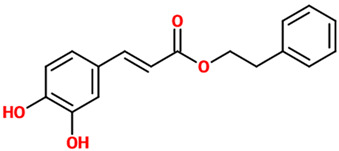
|
| Rats treated with IFOS |
|
[28,29] | |||
| Mouse model of HD (3-nitropropionic acid-induced) |
|
[31] | |||
| BV-2 cells treated with LPS |
|
[27] | |||
| PC12 cells treated with (MPP+) |
|
[30] | |||
| Rat cerebellar granule neurons treated with SNP or glutamate/glycine or H2O2 |
|
[38] | |||
| Chlorogenic acid | Ester of caffeic acid and (−)-quinic acid. It belongs to the polyphenol family of esters, including hydroxycinnamic acids (caffeic acid, ferulic acid and p-coumaric acid) with quinic acid. | Cortical mouse neurons treated with L-glutamic acid |
|
[32] |
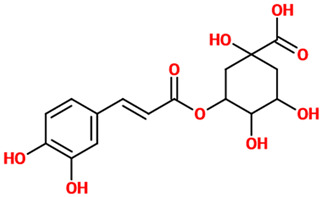
|
| Microglia infected with herpes simplex virus |
|
[33] | |||
| Rats treated with H2O2 |
|
[35] | |||
| Mouse model of epilepsy (pilocarpine-induced) |
|
[36] | |||
| PC12 cells treated with ethanol |
|
[37] | |||
| Rat cerebellar granule neurons treated with SNP |
|
[38] | |||
| Ferulic acid | Natural phenylpropanoid found in Euphorbia hylonoma herbs. It is a substituted derivative of trans-cinnamic acid. | N/A (untreated mice) |
|
[39] |

|
| N/A (untreated mice) |
|
[40] | |||
| Rat model of PD (ROT-induced) |
|
[41] | |||
| Microglial cells treated with LPS |
|
[42] | |||
| Neuro-2a cells treated with H2O2 |
|
[43] | |||
| Mouse model of chronic unpredictable mild stress |
|
[44] | |||
| PC12 cells treated with LPS |
|
[45] | |||
| Rat model of focal cerebral ischemic injury |
|
[46] | |||
| Hypoxia-stressed PC12 cells |
|
[47] | |||
| Gallic acid | Phenolic acid classified as trihydroxybenzoic acid. It is found in gallnuts, sumac, witch hazel, tea leaves, oak bark, and in several other plants. | Mice, Neuro-2A, and primary microglial cells treated with Aβ |
|
[48] |
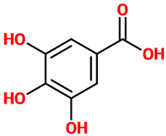
|
| Rat model of TBI |
|
[49] | |||
| Transgenic mice model of AD (APP/PS1) |
|
[50] | |||
| Transgenic mice model of AD (APP/PS1) |
|
[53] | |||
| Rat model of TBI |
|
[54] | |||
| Mouse model of diabetes (STZ-induced) |
|
[55] | |||
| Rats treated with cyclophosphamide |
|
[56] | |||
| Rats treated with sodium arsenite |
|
[57] | |||
| Rat model of AD (AlCl3-induced) |
|
[58] | |||
| Rosmarinic acid | A polyphenol constituent of many culinary herbs such as rosemary, mint, and basil. From the chemical point of view, it represents a caffeic acid ester, with tyrosine giving another phenolic ring via dihydroxyphenyl-lactic acid. | Kindling mouse model (PTZ-induced) |
|
[22] |

|
| Kindling mouse model (PTZ and pilocarpine-induced) |
|
[23] | |||
| Rats exposed to noise |
|
[59] | |||
| C6 glial cells treated with H2O2 |
|
[60,61] | |||
| Rat model of SCI |
|
[62] | |||
| Mouse model of a chronic restraint stress |
|
[63] | |||
| Rat organotypic hippocampal slice cultures treated with scopolamine |
|
[64] | |||
| Rat model of neuropathic pain |
|
[65] | |||
| Acetylsalicylic acid | A weakly acidic substance widely used as a medication to reduce pain, fever, as well as inflammatory processes. Chemically, it represents an acetyl derivative of salicylic acid. | Rats treated with tetrachlorodibenzo-p-dioxin |
|
[66] |

|
| HIV-1 transgenic rat |
|
[67] | |||
| Rat model of ischemia |
|
[69] | |||
| Mouse bone marrow-derived immature dendritic cells treated with LPS |
|
[70] | |||
| BV-2 cells treated with LPS |
|
[71] | |||
| Tannic acid | A specific form of tannins, a class of astringent, polyphenolic biomolecules, characterized by a very efficient metal chelating activity. | N/A (untreated rats) |
|
[72] |

|
| Rats treated with lead acetate |
|
[73] | |||
| Rat model of ischemia/reperfusion injury |
|
[74] | |||
| Rat model of MCAO |
|
[75] | |||
| Protocatechuic acid | A dihydroxybenzoic acid representing a major metabolite of antioxidant polyphenols found in green tea. It also possesses anti-inflammatory properties. | PC12 cells treated with H2O2 |
|
[76] |

|
| PC12 cells treated with MPP+ |
|
[77] | |||
| PC12 cells treated ROT |
|
[78] | |||
| Zebrafish, mice, and PC12 treated with 6-OHDA |
|
[79] | |||
| BV2 cells treated with LPS |
|
[80] | |||
| Rat model of diabetes (STZ-induced) |
|
[81] | |||
| Cerebellar granule neurons treated with H2O2 and BV2 cells treated with LPS |
|
[82] | |||
| Mice treated with sodium arsenate |
|
[83] | |||
| PC12 cells treated with Aβ and α-Syn |
|
[84] | |||
| p-coumaric acid | A hydroxycinnamic acid representing the hydroxy derivative of cinnamic acid. Among the three isomers of coumaric acid (o-, m-, and p-coumaric acid), p-coumaric acid represents the most abundant isomer that can found in nature. | Rat model of SNI |
|
[86] |
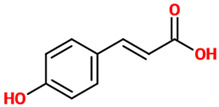
|
| Rat model of SCI |
|
[87] | |||
| Rat model of embolic cerebral ischemia |
|
[88] | |||
| Rat model of ischemia/reperfusion injury |
|
[89] | |||
| Mice treated with LPS |
|
[90] | |||
| SH-SY5Y cells and primary rat cortical neurons treated with corticosterone |
|
[91] | |||
| Sinapic acid | A small naturally occurring hydroxycinnamic acid belonging to the phenylpropanoid family. Due to its well-known ability to absorb laser radiation and donate protons to the analyte of interest, it is frequently used as a matrix in MALDI mass spectrometry experiments. | Mouse model of AD (Aβ-induced) |
|
[93] |
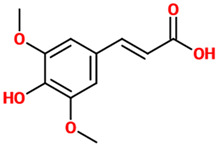
|
| Rat model of early PD (6-OHDA-induced) |
|
[94] | |||
| Rat model of global cerebral ischemia |
|
[95] | |||
| Mice treated with kainic acid |
|
[96] | |||
| Ellagic acid | An organic heterotetracyclic compound found in different fruits and vegetables. From the chemical point of view, it represents the dilactone of hexahydroxydiphenic acid. | Rat model of sporadic AD (STZ-induced) |
|
[97] |
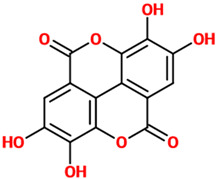
|
| Rat models of scopolamine- and diazepam-induced cognitive impairments |
|
[98] | |||
| Rat model of nerve injury (photothrombosis-induced) and OGD/R model in neural stem cells |
|
[99] | |||
| Rat model of PD (6-OHDA-induced) |
|
[100] | |||
| Rat model of neonatal hypoxic-ischemic brain injury |
|
[101] | |||
| Salicylic acid | A plant hormone representing a precursor to and a metabolite of acetylsalicylic acid (commonly known as aspirin). | Mice treated with METH |
|
[102] |
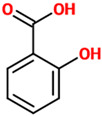
|
| Primary cortex neurons treated with paclitaxel and cisplatin |
|
[103] | |||
| Syringic acid | A dimethoxybenzene that is 3,5-dimethyl ether derivative of gallic acid having a role as a plant metabolite. It can be found in several plants such as Ardisia elliptica. | Rat model of brain ischemia injury |
|
[109] |
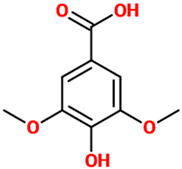
|
| Rat model of SCI |
|
[110] | |||
| Hippocampal neurons subjected to OGD/R |
|
[111] | |||
| Rat model of diabetes (STZ-induced) |
|
[112] | |||
| Rats treated with deltamethrin |
|
[113] | |||
| Rat model of AD (AlCl3-induced) |
|
[114] | |||
| Retinal ganglion cells treated with H2O2 |
|
[115] | |||
| Cinnamic aldehyde | A phenylpropanoid synthesized by the shikimate pathway giving to cinnamon its characteristic flavor and odor. It can be found in the bark of cinnamon trees as well as other species of the genus Cinnamomum. | Mouse model of PD (MPTP-induced) and BE(2)-M17 cells treated with MPTP |
|
[117] |
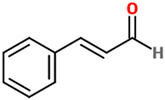
|
| Mouse model of permanent cerebral ischemia |
|
[118] | |||
| Rabbit model of early brain injury (subarachnoid hemorrhage-induced) |
|
[119] | |||
| SH-SY5Y cells treated with Aβ |
|
[120] | |||
| PC-12 cells treated with METH |
|
[121] | |||
| Aged rats treated with METH |
|
[122] | |||
| Rat model TBI |
|
[123] | |||
| Mice subjected to acute or chronic stress |
|
[124] |
